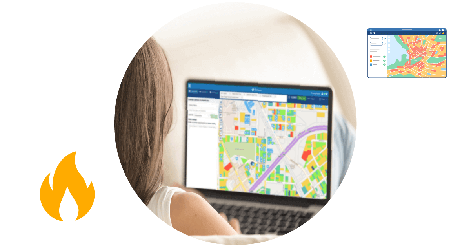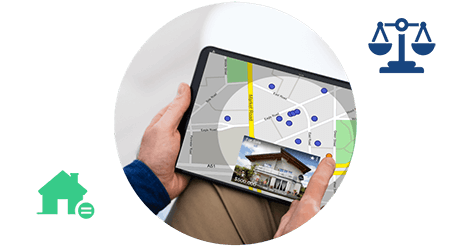Using Market Heatmaps to Identify Hot Real Estate Opportunities

With their colorful, visually-striking map overlays, Market Heatmaps are a versatile tool that can help you quickly identify areas with high demand and low supply, make informed investment decisions, and avoid costly mistakes.
However, they remain one of the most under-leveraged tools in a real estate investor's arsenal.
In this blog, we're taking a look at everything you need to know about Market Heatmaps, how to use them to inform your investment strategy, and so much more.
Let's dive in.
Benefits of using a Market Heatmap
PropertyRadar's Market Heatmap
What is a Market Heatmap?
A Market Heatmap is a graphical representation of real estate data that helps real estate investors identify trends and patterns in a particular market. It uses color coding to show the intensity of certain metrics such as home prices, rental prices, vacancy rates, and more.
The Market Heatmap allows investors to quickly identify areas of high demand and low supply, potential growth opportunities, and areas to avoid.
Different Types of Market Heatmaps
There are different types of Market Heatmaps that investors can use depending on their specific needs:
Sales Heatmaps
Sales Heatmaps are a valuable tool for real estate investors who want to know where the most active markets are. This type of Market Heatmap shows the intensity of real estate sales activity in a given area.
The colors on the map represent the number of homes sold in each area, with red indicating the highest number of sales. Sales Heatmaps can help investors identify neighborhoods with high sales activity, indicating a high demand for real estate.
You can use this sales data to determine which areas are likely to have the most appreciation potential in the future.
Price Heatmaps
Price Heatmaps identify areas with the highest home prices. This type of Market Heatmap shows the intensity of home prices in a given area.
The colors on the map represent the average price of homes in each area, with red indicating the highest prices. Price Heatmaps can help real estate investors identify areas where they may be able to purchase undervalued properties that have the potential for appreciation in the future.
Based on their investment goals and budget, investors can also use Price Heatmaps to determine which areas are too expensive to invest in.
Rental Heatmaps
Rental Heatmaps are useful for investors interested in buying and renting out properties. This type of Market Heatmap shows the intensity of rental prices in a given area.
The colors on the map represent the average rental price of homes in each area, with red indicating the highest rental prices. Rental Heatmaps can help investors determine which neighborhoods are most in demand for rentals and where they can earn the highest rental income.
Additionally, Rental Heatmaps can help investors identify areas where rental prices may be too low to make an investment worthwhile.
Vacancy Heatmaps
Vacancy Heatmaps are essential for investors who want to identify areas with high vacancy rates. This type of Market Heatmap shows the intensity of vacant homes in a given area. The colors on the map represent the percentage of currently vacant homes, with red indicating the highest vacancy rates.
Vacancy Heatmaps can help investors identify areas where there may be oversupply and where prices may be depressed due to high competition among sellers. Alternatively, you can also identify neighborhoods with few vacant properties, indicating high demand for real estate.
Advantages of Using a Market Heatmap
Market Heatmaps Save Time: Market Heatmaps help real estate investors save time by quickly identifying areas with high demand and low supply. By identifying these areas, you can focus on areas with the most growth potential and avoid areas that may not be worth their time.
They Help You Make Better Decisions: With the help of Market Heatmaps, investors can make informed decisions based on real data instead of relying on their intuition or hearsay. Data at your fingertips will help you make better investment decisions and avoid costly mistakes.
They Ramp Up Your Efficiency: Market Heatmaps provide investors with a visual representation of real estate data, which makes it easier to identify trends and patterns. This, in turn, improves efficiency in decision-making and reduces the risk of making uninformed investment decisions.
The Can Lead To Increased Profitability: Using Market Heatmaps can help you identify high-growth areas and invest in properties likely to appreciate over time. By knowing where growth is happening, you can have a better chance for profitability and significantly higher returns on investment.
How to Use a Market Heatmap
To effectively use a Market Heatmap, you'll general want to follow a series of steps that includes choosing the type of Market Heatmap that best aligns with your investment goals, selecting your preferred geographic area, interpreting the color-coded legend, identifying areas of high and low intensity, and using this information to make informed investment decisions.
- Choose the type of Market Heatmap that best aligns with your investment goals, such as Sales Heatmaps, Price Heatmaps, Rental Heatmaps, or Vacancy Heatmaps.
- Select the geographic area that you're interested in, such as a city, neighborhood, or zip code.
- Use the color-coded legend to interpret the data on the map. The colors represent the intensity of the selected metric, often with red indicating the highest values and green showing the lowest values.
- Identify areas with high intensity, high demand, and low intensity, low demand.
- Use this information to inform your investment strategy. For example focusing on areas with high demand and potential for appreciation.
How to Analyze Data Provided by Market Heatmaps
- Look for patterns on the map, such as high or low-intensity clusters.
- Compare the Market Heatmap data to historical trends to identify whether the area is trending upwards or downwards.
- Use the Market Heatmap data to identify potential areas for investment or areas to avoid.
- Use additional resources like demographic data, crime rates, and local school ratings to further analyze the market and make informed investment decisions.
Tips on Interpreting Market Heatmap Data
- Keep your investment goals in mind when interpreting the data. For example, to purchase a property for rental income, focus on areas with high rental prices.
- Consider the size of the area when interpreting the data. For example, a small area with high demand may be more valuable than a large area with low demand.
- Use the Market Heatmap data in combination with other data sources to get a more complete picture of the market.
- Don't solely rely on the Market Heatmap data. Use it as a starting point for further analysis and research. For example, according to a Redfin survey, homes in "hot" neighborhoods sell 13% faster and for 2.6% more than homes in other areas.
Benefits of Using a Market Heatmap
Market Heatmaps vs. Other Investment Strategies
Using Market Heatmaps can be more efficient than other investment strategies, such as physically visiting potential investment properties.
Visiting properties in person, which you can do by Driving For Dollars, can be time-consuming and costly, especially if the investor considers properties in different geographic locations. On the other hand, Market Heatmaps can provide you with a wealth of information about a particular market without ever leaving your computer.
You can quickly and easily identify areas with high demand, low supply, high rental prices, etc. Given Market Heatmaps' intuitive, visual nature, you can save time and money, allowing you to focus your efforts on the areas with the most growth potential.
Additionally, Market Heatmaps can help investors avoid costly mistakes by providing real data to base their decisions. Other investment strategies, such as relying on intuition, can lead to uninformed investment decisions and potentially significant financial losses.
Market Heatmaps work - just look at the stats!
Studies have shown that using Market Heatmaps can lead to better investment decisions and higher returns for real estate investors.
For example, a study by Zillow found that investors who used Market Heatmaps to identify areas with high rental demand saw an average return on investment of 7.7%, compared to an average return of 5.9% for investors who did not use Market Heatmaps.
Another study by ATTOM Data Solutions found that investors who used Market Heatmaps to identify areas with high appreciation rates saw an average return on investment of 31%, compared to an average return of 19% for investors who did not use Market Heatmaps.
PropertyRadar's Market Heatmap
PropertyRadar's Market Heatmap is a powerful tool that allows real estate investors to visualize properties and analyze areas based on several different search attributes and geographic boundary types. As mentioned throughout this blog, it's designed to help you make more informed investment decisions and gain insights into their current or potential market.
PropertyRadar's Market Heatmap Overview
PropertyRadar's Market Heatmap allows users to visually see properties on a map based on several search attributes, including
- Property type
- Square footage
- Year built
- Estimated value
- Estimated equity
- Assessed value
- Debt
- Estimated value per square foot
- Assessed to estimated value
- Estimated tax rate
- Turnover sales
- For sale
- Foreclosures
- Vacancy
- Ownership type
- Owner age
- Owner gender
- Children present
- Owner education
- Owner income
- Business ownership
Additionally, users can analyze areas based on several different geographic boundary types, including municipalities, zip codes, counties, tracts, block groups, and congressional districts. You can select from 25 different metrics to display in heatmap overlays, allowing you to see specific insights into what exists in the area and the potential benefits or risks.
Benefits of Using PropertyRadar's Market Heatmap
There are several benefits to using the Market Heatmap in PropertyRadar.
First, users can visually see properties on a map based on specific search criteria, making it easier to identify areas with high demand and low supply.
Additionally, users can analyze areas based on several different geographic boundary types, allowing them to quickly identify boundary segments and gain insights into their current or potential market.
Another benefit is the ability to see specific insights into the area's potential benefits or risks.
How to Access PropertyRadar's Market Heatmap
To access PropertyRadar's Market Heatmap, users must first create an account with PropertyRadar. Once logged in, users can access the Market Heatmap tool under the "Explore" tab. From there, you can customize their search criteria and view properties and areas on the map.
Conclusion
Using a Market Heatmap is a game-changer for real estate investors looking to make informed investment decisions and gain a competitive advantage in the market. It can save time, provide real data, and help investors avoid costly mistakes.
We strongly encourage you to incorporate Market Heatmaps into your investment strategy to identify areas with the most potential for growth and maximize your returns.
And, for those looking for a powerful tool to help them with their real estate investing strategies, PropertyRadar's Market Heatmap is an excellent choice.
With its comprehensive search criteria and boundary analysis, PropertyRadar's Market Heatmap is a valuable resource that can help investors gain insights into their current or potential market and make more informed investment decisions.
So don't wait any longer - start using Market Heatmaps and take your real estate investing to the next level. And for additional resources on using Market Heatmaps, including PropertyRadar's Market Heatmap, visit our website today. Thank you for reading, and happy investing!


